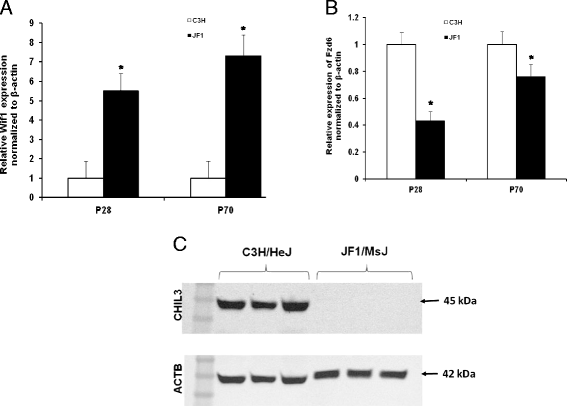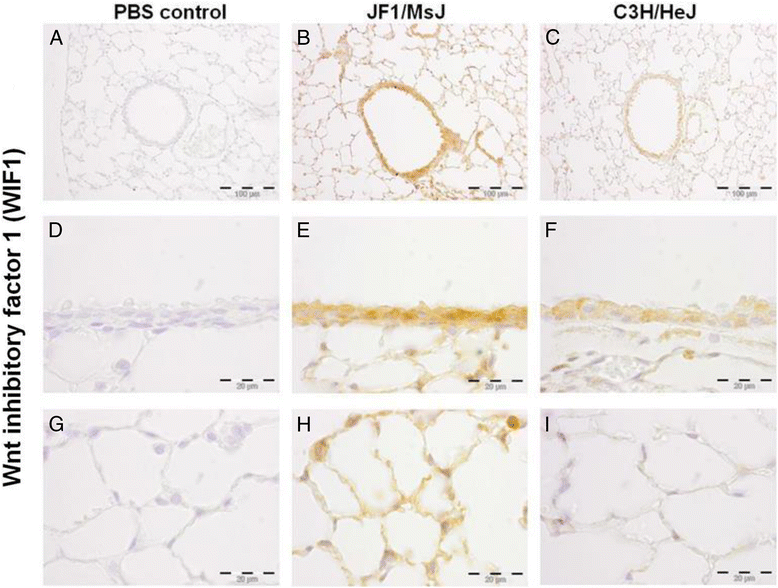Transcriptomic analysis comparing mouse strains with extreme total lung capacities identifies novel candidate genes for pulmonary function
- PMID: 28793908
- PMCID: PMC5551015
- DOI: 10.1186/s12931-017-0629-3
Transcriptomic analysis comparing mouse strains with extreme total lung capacities identifies novel candidate genes for pulmonary function
Abstract
Background: Failure to attain peak lung function by early adulthood is a risk factor for chronic lung diseases. Previously, we reported that C3H/HeJ mice have about twice total lung capacity (TLC) compared to JF1/MsJ mice. We identified seven lung function quantitative trait loci (QTL: Lfnq1-Lfnq7) in backcross/intercross mice derived from these inbred strains. We further demonstrated, superoxide dismutase 3, extracellular (Sod3), Kit oncogene (Kit) and secreted phosphoprotein 1 (Spp1) located on these Lfnqs as lung function determinants. Emanating from the concept of early origin of lung disease, we sought to identify novel candidate genes for pulmonary function by investigating lung transcriptome in C3H/HeJ and JF1/MsJ mice at the completion of embryonic development, bulk alveolar formation and maturity.
Methods: Design-based stereological analysis was performed to study lung structure in C3H/HeJ and JF1/MsJ mice. Microarray was used for lung transcriptomic analysis [embryonic day 18, postnatal days 28, 70]. Quantitative real time polymerase chain reaction (qRT-PCR), western blot and immunohistochemical analysis were used to confirm selected differences.
Results: Stereological analysis revealed decreased alveolar number density, elastin to collagen ratio and increased mean alveolar volume in C3H/HeJ mice compared to JF1/MsJ. Gene ontology term "extracellular region" was enriched among the decreased JF1/MsJ transcripts. Candidate genes identified using the expression-QTL strategy include: ATP-binding cassette, sub-family G (WHITE), member 1 (Abcg1), formyl peptide receptor 1 (Fpr1), gamma-aminobutyric acid (GABA) B receptor, 1 (Gabbr1); histocompatibility 2 genes: class II antigen E beta (H2-Eb1), D region locus 1 (H2-D1), and Q region locus 4 (H2-Q4); leucine rich repeat containing 6 (testis) (Lrrc6), radial spoke head 1 homolog (Rsph1), and surfactant associated 2 (Sfta2). Noteworthy genes selected as candidates for their consistent expression include: Wnt inhibitor factor 1 (Wif1), follistatin (Fst), chitinase-like 1 (Chil1), and Chil3.
Conclusions: Comparison of late embryonic, adolescent and adult lung transcript profiles between mouse strains with extreme TLCs lead to the identification of candidate genes for pulmonary function that has not been reported earlier. Further mechanistic investigations are warranted to elucidate their mode of action in determining lung function.
Keywords: Asthma; Chronic obstructive pulmonary disease; Lung development; Transcriptomics; WNT Signaling.
Conflict of interest statement
Ethics approval and consent to participate
Human participants: human data or human tissue: not applicable.
Mice: The use of animals was in accordance with the German Law of Animal Protection and approved by the Bavarian Animal Research Authority and the Animal Research Authority of Schleswig-Holstein (reference number V312–72241.123-3. All procedures were also approved by IACUC of the University of Pittsburgh, PA, USA. Frozen and paraffin embedded tissues were procured to carry out experiments at SRM University, India according to the Institutional Animal Ethics Committee (IAEC) permission [79/IAEC/2013].
Consent for publication
not applicable.
Competing interests
The authors declare that they have no competing interests.
Publisher’s Note
Springer Nature remains neutral with regard to jurisdictional claims in published maps and institutional affiliations.
Figures




Similar articles
-
Candidate genes controlling pulmonary function in mice: transcript profiling and predicted protein structure.Physiol Genomics. 2007 Nov 14;31(3):410-21. doi: 10.1152/physiolgenomics.00260.2006. Epub 2007 Sep 5. Physiol Genomics. 2007. PMID: 17804602
-
Secreted phosphoprotein 1 is a determinant of lung function development in mice.Am J Respir Cell Mol Biol. 2014 Nov;51(5):637-51. doi: 10.1165/rcmb.2013-0471OC. Am J Respir Cell Mol Biol. 2014. PMID: 24816281 Free PMC article.
-
Superoxide dismutase 3, extracellular (SOD3) variants and lung function.Physiol Genomics. 2009 May 13;37(3):260-7. doi: 10.1152/physiolgenomics.90363.2008. Epub 2009 Mar 24. Physiol Genomics. 2009. PMID: 19318538 Free PMC article.
-
Association studies of lung function in mice.Dtsch Tierarztl Wochenschr. 2008 Jul;115(7):276-84. Dtsch Tierarztl Wochenschr. 2008. PMID: 18672739 Review.
-
Genetic and Epigenetic Regulation of the Innate Immune Response to Gout.Immunol Invest. 2023 Apr;52(3):364-397. doi: 10.1080/08820139.2023.2168554. Epub 2023 Feb 6. Immunol Invest. 2023. PMID: 36745138 Review.
Cited by
-
Pneumonia: host susceptibility and shared genetics with pulmonary function and other traits.Clin Exp Immunol. 2019 Dec;198(3):367-380. doi: 10.1111/cei.13367. Epub 2019 Oct 1. Clin Exp Immunol. 2019. PMID: 31487037 Free PMC article.
-
Long-term alterations in lung epithelial cells after EL-RSV infection exacerbate allergic responses through IL-1β-induced pathways.Mucosal Immunol. 2024 Oct;17(5):1072-1088. doi: 10.1016/j.mucimm.2024.07.007. Epub 2024 Jul 27. Mucosal Immunol. 2024. PMID: 39069078 Free PMC article.
-
Chromosome-level genome of Neodon fuscus sheds light on the evolution and plateau adaptation of N. fuscus and Neodon.BMC Genomics. 2025 Jun 2;26(1):554. doi: 10.1186/s12864-025-11709-4. BMC Genomics. 2025. PMID: 40457188 Free PMC article.
-
A candidate gene identification strategy utilizing mouse to human big-data mining: "3R-tenet" in COPD genetic research.Respir Res. 2018 Jun 6;19(1):92. doi: 10.1186/s12931-018-0795-y. Respir Res. 2018. PMID: 29871630 Free PMC article.
References
-
- Krauss-Etschmann S, Bush A, Bellusci S, Brusselle GG, Dahlen SE, Dehmel S, Eickelberg O, Gibson G, Hylkema MN, Knaus P, Konigshoff M, Lloyd CM, Macciarini P, Mailleux A, Marsland BJ, Postma DS, Roberts G, Samakovlis C, Stocks J, Vandesompele J, Wjst M, Holloway J. Of flies, mice and men: a systematic approach to understanding the early life origins of chronic lung disease. Thorax. 2013;68:380–384. doi: 10.1136/thoraxjnl-2012-201902. - DOI - PubMed
-
- Lange P, Celli B, Agusti A, Boje Jensen G, Divo M, Faner R, Guerra S, Marott JL, Martinez FD, Martinez-Camblor P, Meek P, Owen CA, Petersen H, Pinto-Plata V, Schnohr P, Sood A, Soriano JB, Tesfaigzi Y, Vestbo J. Lung-Function Trajectories Leading to Chronic Obstructive Pulmonary Disease. N Engl J Med. 2015;373:111–122. doi: 10.1056/NEJMoa1411532. - DOI - PubMed
Publication types
MeSH terms
Grants and funding
LinkOut - more resources
Full Text Sources
Other Literature Sources
Molecular Biology Databases
Research Materials
Miscellaneous

